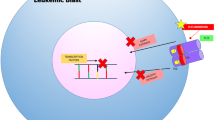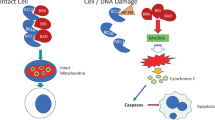Abstract
Therapies for AML have remained mostly unchanged since the introduction of anthracyline- and cytarabine-based regimens in the 1970s. Though some changes have been made in the dosing of anthracylines, in the choice of consolidation regimens versus allogeneic stem cell transplant, and in supportive care, clinical outcomes remain poor for most patients. As we continue to strive for better treatment options to improve upon outcomes, different agents, both chemotherapeutic and targeted therapies, are being studied. Here we discuss new chemotherapeutic agents that show promise in recent clinical trials and attempt to answer the question if there are any new effective cytotoxic chemotherapy agents out there.
Similar content being viewed by others
References
Papers of particular interest, published recently, have been highlighted as: • Of importance
Lowenberg B, Downing JR, Burnett A. Acute myeloid leukemia. New Engl J Med. 1999;341:1051–62.
National Cancer Institute: SEER Cancer Statistics Review, 2975–2009. Available at http://seer.cancer.gov/csr/1975_2009pops09/. Accessed December 2012.
Estey EH. Therapeutic options for acute myelogenous leukemia. Cancer. 2001;92:1059–73.
Appelbaum FR, Gundacker H, Head DR, et al. Age and acute myeloid leukemia. Blood. 2006;107:3481–5.
Estey EH. Acute myeloid leukemia and myelodysplastic syndromes in older patients. J Clin Oncol. 2007;25:1908–15.
Breems DA, Van Putten WL, Huijgens PC, et al. Prognostic index for adult patients with acute myeloid leukemia in first relapse. J Clin Oncol. 2005;23:1969–78.
Bennet J, Young M, Andersen J, et al. Long-term survival in acute myeloid leukemia: the Eastern Cooperative Oncology Group experience. Cancer. 1997;80:2205–9.
Byrd JC, Mrözek K, Dodge R, et al. Pretreatment cytogenetic abnormalities are predictive of induction success, cumulative incidence of relapse, and overall survival in adult patients with de novo acute myeloid leukemia; results from the Cancer and Leukemia Group B (CALGB 8461). Blood. 2002;100:4325–36.
Yates JW, Wallace Jr HJ, Ellison RR, et al. Cytosine arabinoside (NSC-63878) and daunorubicin (NSC-83142) therapy in acute nonlymphocytic leukemia. Cancer Chemother Rep. 1973;57:485–8.
Fernandez HF, Sun Z, Yao X, et al. Anthracycline dose intensification in acute myeloid leukemia. N Engl J Med. 2009;361:1249–59.
Löwenberg B, Ossenkoppele GJ, van Putten W, et al. High-dose daunorubicin in older patients with acute myeloid leukemia. N Engl J Med. 2009;361:1235–48.
Döhner H, Estey EH, Amadori S, et al. Diagnosis and management of acute myeloid leukemia in adults: recommendations from an international expert panel, on behalf of the European LeukemiaNet. Blood. 2010;115:453–74.
Burnett AK, Russell NH, McMullin MF, et al. A randomised comparison of clofarabine versus low dose Ara-C as first line treatment for older patients with AML. Blood (ASH Ann Meet Abstr). 2012;120:889.
Farderl S, Wetzler M, Rizzieri D, et al. Clofarabine plus cytarabine compared with cytarabine alone in older patients with relapsed or refractory acute myelogenous leukemia: results from the CLASSIC I trial. J Clin Oncol. 2012;30:2942–9.
Faderl S, Ravandi F, Huang X, et al. Clofarabine plus low-dose cytarabine followed by clofarabine plus low-dose cytarabine alternating with decitabine in acute myeloid leukemia frontline therapy for older patients. Cancer. 2012;118:4471–7.
• Nazha A, Ravandi F, Kantarjian HM, et al. Clofarabine, idarubicin, and cytarabine (CIA) as frontline therapy for patients < = 60 years with newly diagnosed acute myeloid leukemia (AML). Blood (ASH Ann Meet Abstr). 2012;120:47. Addition of clofarabine to “7 + 3” induction chemotherapy in younger AML patients.
O’Brien S, Rizzieri DA, Vey N, et al. Elacytarabine has single-agent activity in patients with advanced acute myeloid leukaemia. Br J Haematol. 2012;158:581–8.
Sandvold ML, Galmarini C, Myhren F, et al. The activity of the lipophilic nucleoside derivatives elacytarabine and CP-4126 in a panel of tumor cell lines resistant to nucleoside analogues. Nucleosides, Nucleotides Nucleic Acids. 2010;29:386–93.
Breistol K, Balzarini J, Sandvold ML, et al. Antitumor activity of P-4055 (elaidic acid-cytarabine) compared to cytarabine in metastatic and s.c. human tumor xenograft models. Cancer Res. 1999;59:2944–9.
• Giles FJ, Vey N, Rizzieri D, et al. Phase I and pharmacokinetic study of elacytarabine, a novel 5’elaidic acid derivative of cytarabine, in adults with refractory hematologic malignancies. Leukemia. 2012;26:1686–9. Phase I testing of Elacytarabine in hematologic malignancies.
Giles F, O’Brien S, Cortes J, et al. Outcome of patients with acute myelogenous leukemia after second salvage therapy. Cancer. 2005;104:547–54.
Azuma A, Huang P, Matsuda A, et al. 2’-C-cyano-2’-deoxy-1-β-D-arabino-pentofuranosyl cytosine: a novel anticancer nuceloside analog that causes both DNA strand breaks and G2 arrest. Mol Pharmacol. 2001;59:725–31.
Liu X, Wang Y, Benaissa S, et al. Homologous recombination as a resistance mechanism to replication-induced double-strand breaks caused by the anti-leukemia agent, CNDAC. Blood. 2010;116:1737–46.
Kantarjian H, Garcia-Manero G, O’Brien S, et al. Phase I clinical and pharmacokinetic study of oral sapacitabine in patients with acute leukemia and myelodysplastic syndrome. J Clin Oncol. 2010;28:285–91.
• Kantarjian H, Faderl S, Garcia-Manero G, et al. Oral sapacitabine for the treatment of acute myeloid leukaemia in elderly patients: a randomized phase 2 study. Lancet Oncol. 2012;13:1096–104. Phase II study of oral regimens of sapacitabine monotherapy in elderly AML.
Holowiecki J, Grosicki S, Robak T, et al. Addition of cladribine to daunorubicin and cytarabine increases complete remission rate after a single course of induction treatment in acute myeloid leukemia: multicenter, phase III study. Leukemia. 2004;18:989–97.
• Holowiecki J, Grosicki S, Giebel S, et al. Cladribine, but not fludarabine, added to daunorubicin and cytarabine during induction prolongs survival of patients with acute myeloid leukemia: a multicenter, randomized phase III study. J Clin Oncol. 2012;30:2441–8. Phase III Study showing increased OS in young AML pts with addition of cladribine to “7 + 3” induction chemotherapy.
Hawtin RE, Stockett DE, Byl JA, et al. Voreloxin is an anticancer quinolone derivative that intercalates DNA and poisons topoisomerase II. PLoS One. 2010;5:e10186.
Advani RH, Hurwitz HI, Gordon MS, et al. Voreloxin, a first-in-class anticancer quinolone derivative, in relapsed/refractory solid tumors: a report on two dosing schedules. Clin Cancer Res. 2010;16:2167–75.
Lancet JE, Karp J, Cripe L, et al. Phase Ib/II pharmacokinetic/pharmacodynamic (PK/PD) study of combination voreloxin and cytarabine in relapsed or refractory AML patients [abstract 7005]. Presented at American Society of Clinical Oncology (ASCO) Annual Meeting. Orlando, Florida; May 29-June 2, 2009.
Roboz GJ, Lancet JE, Cripe LD, et al. Final results of a phase II pharmacokinetic/pharmacodynamic (PK/PD) study of combination voreloxin and cytarabine in patients with relapsed or refractory acute myeloid leukemia [abstract 6526]. American Society of Clinical Oncology (ASCO) Annual Meeting. Chicago, IL; June 4–8, 2010.
Stuart RK, Kashani FR, Cripe LD, et al.: Voreloxin single-agent treatment for older patients (60 years or older) with previously untreated acute myeloid leukemia: Final results from a phase II study with three schedules [abstract 6525]. American Society of Clinical Oncology (ASCO) Annual Meeting. Chicago, IL; June 4–8, 2010.
Mehta C, Michelson G, Salganik M, et al. Adaptive design of VALOR, a phase III trial of vosaroxin or placebo in combination with cytarabine for patients with first relapsed or refractory acute myeloid leukemia [abstract TPS201]. American Society of Clinical Oncology (ASCO) Annual Meeting. Chicago, IL; June 3–7, 2011.
Abbas JA, Stuart RK. Vosaroxin: a novel antineoplastic quinolone. Expert Opinions Investigational Drugs. 2012;21:1223–33.
Feldman EJ, Lancet JE, Kolitz JE, et al. First-in-man study of CPX-351: a liposomal carrier containing cytarabine and daunorubicin in a fixed 5:1 molar ratio for the treatment of relapsed and refractory acute myeloid leukemia. J Clin Oncol. 2011;29:979–85.
Tardi P, Johnstone S, Harasym N, et al. In vivo maintenance of synergistic cytarabine:daunorubicin ratios greatly enhances therapeutic efficacy. Leuk Res. 2009;33:129–39.
• Zediner JF, Gerber JM, Blackford A, et al. Randomized phase II trial of time-sequential therapy (TST) with flavopiridol (alvocidib), ara-c and mitoxantrone (FLAM) versus “7 + 3” for adults ages 70 years and under with newly diagnosed acute myeloid leukemia (AML). Blood (ASH Annual Meeting Abstracts). 2012;120:47. Ongoing study assessing FLAM vs “7 + 3” in younger AML patients with intermediate and high-risk features.
Karp JE, Blackford A, Smith BD, et al. Clinical activity of sequential flavopiridol, cytosine arabinoside, and mitoxantrone with adults with newly diagnosed poor risk acute myelogenous leukemia. Leuk Res. 2010;34:877–82.
Conflict of Interest
Alice Mims declares that she has no conflict of interest.
Robert K. Stuart received grants from 430 Sunesis, Novartis, Coronado Biosciences, Millenium, Celtic Ther-431 apeutics, Spectrum Pharmaceuticals, Pfizer, Celator; Honoraria 432 from Sunesis, Moffitt Cancer Center, travel/accommodations: Sunesis
Author information
Authors and Affiliations
Corresponding author
Rights and permissions
About this article
Cite this article
Mims, A., Stuart, R.K. Developmental Therapeutics in Acute Myelogenous Leukemia: Are There Any New Effective Cytotoxic Chemotherapeutic Agents Out There?. Curr Hematol Malig Rep 8, 156–162 (2013). https://doi.org/10.1007/s11899-013-0158-1
Published:
Issue Date:
DOI: https://doi.org/10.1007/s11899-013-0158-1




